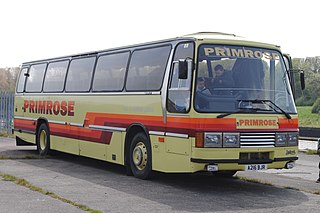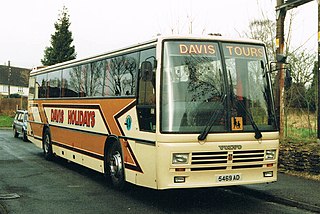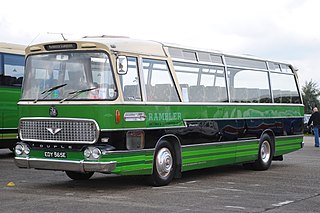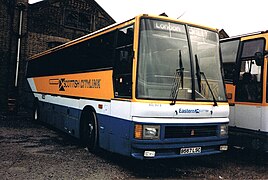Plaxton is an English builder of bus and coach vehicle bodies based in Scarborough. Founded in 1907 by Frederick William Plaxton, it became a subsidiary of Alexander Dennis in May 2007. Since 2019, the maker was acquired by Canadian bus manufacturer New Flyer which then became NFI Group.

Seddon Atkinson Vehicles Limited, a manufacturer of large goods vehicles based in Oldham, Greater Manchester, England, was formed after the acquisition in 1970 of Atkinson Vehicles Limited of Preston by Seddon Diesel Vehicles Limited of Oldham. In 1974, the firm was acquired by International Harvester, which sold it in March 1984 to the Spanish group Enasa which made it a subsidiary of Pegaso. In 1990, it became part of Iveco which used the brand for various types of specialised vehicles in the United Kingdom. The range of models produced included EuroMover, Pacer and Strato, which are aimed at refuse collection, recycling and construction operators.

The Leyland Titan was a forward-control chassis with a front-mounted engine designed to carry double-decker bus bodywork. It was built mainly for the United Kingdom market between 1927 and 1942, and between 1945 and 1969.

Duple Coachbuilders was a coach and bus bodybuilder in England from 1919 until 1989.

Duple Metsec was a bus bodywork builder based in West Midlands of England in the United Kingdom. It usually supplied body kits for bus assembly overseas.

Barton Transport was a bus company that operated in Nottinghamshire from 1908 until 1989.

The Plaxton Paramount was a design of coach bodywork built by Plaxton. It first appeared at the 1982 British Motor Show and was built until 1992.

The Duple Dominant was a design of a coach bodywork built by Duple between 1972 and 1987. It introduced an all-steel structure and replaced the wooden-framed Duple Vega, Viceroy and Vista models.
Invictaway was an express commuter coach service from Kent to London in the 1980s and 1990s, and was also a holding company for the emerging Arriva group. As a legal entity of the Maidstone & District bus company, after the cessation of the Invictaway coach services, the Invictaway company legal lettering persisted as a holding company for the Arriva subsidiaries in Kent, and some London operations. This company was based in the Armstrong Road M&D depot in Maidstone. This ceased in 1997 when the operations were reconstituted as Arriva London and Arriva Southern Counties.

Thomas Harrington & Sons was a coachbuilder in the county of Sussex from 1897 until 1966, initially at Brighton but from 1930 until the end in a purpose built Art Deco factory in Old Shoreham Road, Hove.

The Leyland Tiger Cub was a lightweight underfloor-engined chassis manufactured by Leyland between 1952 and 1970.

The Daimler Freeline was an underfloor-engined bus chassis built by Daimler between 1951 and 1964. It was a very poor seller in the UK market for an underfloor-engined bus and coach chassis, but became a substantial export success.

The Leyland Tiger was a heavyweight half-cab single-decker bus and coach chassis built by Leyland Motors between 1927 and 1968, except the period of World War II.
H. V. Burlingham was a British coachbuilding business based in Blackpool, Lancashire from 1928 until 1960 when they were taken over by London-based rivals Duple Motor Bodies. Duple initially renamed Burlingham as Duple (Northern) but in 1969 they closed their Hendon factory and concentrated production in Blackpool. Duple coach bodies were built in the former Burlingham premises until Duple itself was liquidated in 1989.

The Leyland Royal Tiger Worldmaster, sometimes simply known as the Leyland Worldmaster, was a mid-underfloor-engined single-decker bus or single-decker coach chassis manufactured by Leyland between 1954 and 1979.

The Bristol LH was a single-decker bus chassis built by Bristol Commercial Vehicles (BCV) in Bristol, England. Nearly 2,000 were built between 1967 and 1982 in a variety of sizes and body types, including some as goods vehicles.

The Duple Laser was a design of a coach bodywork built by Duple between 1983 and 1986. It replaced the long-running Duple Dominant body as Duple's standard medium-height coach of the mid 1980s.

The Duple Calypso was a design of semi-integral coach built by Duple between 1983 and 1984 using running gear from the Bova Europa.

The Duple 300 Series were a range of bus and coach bodywork built by Duple between 1985 and 1989. The range comprised the 3,000 mm high Duple 300 service bus, the 3,200 mm high Duple 320 coach, and the taller 3,400 mm high Duple 340 coach. The 320 and 340 coaches were announced at the Bus and Coach Show at Earls Court in September 1985 as replacements for the previous Laser and Caribbean. Deliveries of these models commenced in 1986, whilst the 300 bus was launched in 1987 as a replacement for the Dominant Bus. After Duple closed down the designs were sold to Plaxton and a small number of additional 320 bodies were built as the Plaxton 321.

The Duple Viceroy was a type of coach bodywork built by Duple between 1966 and 1972. It was initially launched on lightweight front-engined chassis, but it was latterly built on mid-engined and heavyweight chassis as well. A variant of the Viceroy was the Duple Viceroy Express, which had a bus-type entrance door making it suitable for stage carriage work.



















